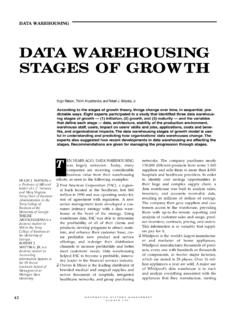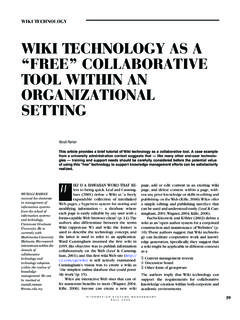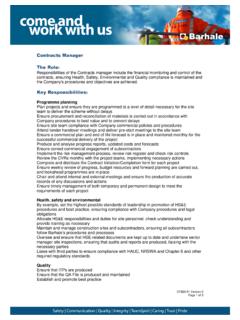Transcription of Chapter 10: Understanding and Managing Vendors
1 Chapter 10. Understanding and Managing Vendors Vendors can be signi cant partners in your information technology (IT). project. They may create, deliver, install, maintain, or support critical com- ponents of your target state. That being the case, implicit in your reliance on the Vendors are one or more of the following: High-performance hardware, software, resources, or support On-time delivery Technical expertise Fast and thorough fault resolution Training Professional relations with your team, customers, and bene ciaries This Chapter has been written to address these expectations. As great as they are, they may be unrealistic. Having served on both sides of the fence in these relationships, it is my observation that vendor management from a project perspective is generally clumsy and haphazard.
2 If true, that tends to make these relationships less bene cial and rewarding to both parties. Working on the assumption that we, as customers, cannot x any vendor problems, we can still be aware of them and leverage that knowledge to our advantage. We can also acknowledge that large corporations generally make for lousy customers, whether through arrogance, incompetence, carelessness, or sheer size. The same faults can be attributed to many of our Vendors , by the way. ABOUT Vendors . Once you plug a vendor 's name into the plan against a major deliverable, you are assigning responsibility to them and designating them as a critical facilitator of success.
3 Whether they are writing code, delivering systems, or cobbling technology together in your computer rooms, you expect them to perform on time and up to your speci cations. Unless you manage them properly, however, there is plenty of history that suggests their success in this regard is not a sure thing. 2004 by CRC Press LLC. Exhibit 1. Customer vendor Relationship Disconnects The vendor may lack the logistical infrastructure or resource that can meet your needs precisely while servicing other, equally demanding customers. How many superstars in their employ can be dedicated to your Does your view of their deliverables, roles, and responsibilities match theirs?
4 Vendors generally see the customer squeezing relentlessly on price, while demanding scope creep for free. Customers generally see Vendors cherry picking ( , performing easy, pro table work while avoiding the tough, low-margin work that you really need them to produce). a While you are at it, take the same look at your own team. Why is that? Your company may already have paid this particular ven- dor millions, based on a longstanding partnership. Or, you have selected a vendor new to your rm a vendor who now has the opportunity to get wonderful references from you after this project is done, and thus achieve greater penetration within your company with future opportunities.
5 You would think either scenario would provide the vendor with enough sensitivity to your requirements that the vendor marching with you in lock step to the nish line is assured, right? It would probably not happen that way. Honestly, though, one wonders why these relationships cause so much hand wringing and gnashing of teeth on both sides, incidentally. Customers grouse about Vendors , who, in turn, mutter among themselves about the unreasonableness of the customer set. Exhibit 1 offers a dispas- sionate look at client vendor relationships in this manner. Now that we have set the table for the discussion of Managing Vendors , let us look at the key areas.
6 EXISTING Vendors . Many projects require the participation of Vendors that your corporation or agency already has under contract. Vendors whose behavior is gener- ally proscribed by this process typically provide commoditized products or services such as: Network transport voice or data circuits and services Hardware routers, switches, computers, and servers Shrink-wrapped software spreadsheets, accounts payable Operating systems desktop and network Support help desk, fault management, break x . Procurement resellers who deliver equipment and software Staff augmentation short-term help or technical consultants A formalized relationship management team tasked with Managing ven- dor relationships is probably in place in your shop.
7 vendor , product set, or service type may align the team. The focal point may be in a product man- 2004 by CRC Press LLC. Exhibit 2. Rules of Engagement for Your vendor Management Team Make them aware of your project and your interest in leveraging an existing relationship. Provide detailed requirements you look for the vendor to provide. Determine if any requirements are provided, or precluded, by existing contracts between your organization and the vendor . Ask what speci c bene ts may accrue to the project ( , discounts, free services, etc.) by using this incumbent vendor . Understand how you can, and cannot, communicate with the vendor .
8 Agement group, or within the purchasing department. The degree of con- trol they exercise over the relationship may be quite strong. Likewise, such mechanisms can be extremely political, particularly if you approach the vendor without Understanding your vendor management's mission and process. In other words, circumventing their process, either willfully or through unfamiliarity, can be hazardous to your project calendar's health. Therefore, if you intend to leverage existing relationships to buy prod- ucts or services, make it your business to hook up with your internal ven- dor or product management team before you get too far into the process of engaging that vendor .
9 This includes requesting budgetary pricing or initi- ating exploratory conversations regarding services they offer that appeal to you from a project perspective. Exhibit 2 highlights preferred behavior when engaged with the people in your organization who are charged with overseeing vendor contracts. I have seen cases where it is okay to go directly to the vendor without vendor management tagging along. I have also seen the opposite, where I. could talk to a vendor about approved products or services ( , technical things), but was de nitely prohibited from discussing pricing or other busi- ness-related topics. The bottom line is that you need to gauge, as early on as possible, how your company does business with this vendor and whether or not that meets your needs.
10 I have had as many pleasant sur- prises in this area as disappointments. For instance, I learned that existing contracts with two big Vendors provided certain project services at prices far lower than an internal group I was told to use would charge, with the same or better service levels. On the other hand, I have been told that vendor X could not provide a product or service I felt quite certain they could, or that their pricing, ser- vice levels, or availability was disadvantageous to our initiative. Equally distressing is the discovery that vendor management can exercise veto power over certain kinds of purchases, particularly based on technology standards.












